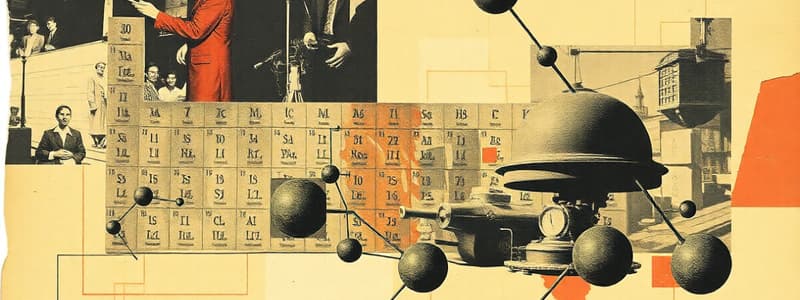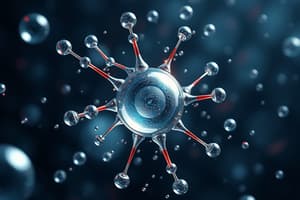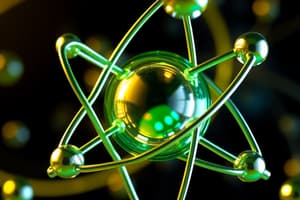Podcast
Questions and Answers
What defines a pure substance as an element?
What defines a pure substance as an element?
- It is made of only one type of atom. (correct)
- It consists of multiple types of atoms.
- It can be either a liquid or solid.
- It can be broken down into simpler substances.
What is the key difference between monoatomic and diatomic molecules?
What is the key difference between monoatomic and diatomic molecules?
- Monoatomic molecules are less stable than diatomic molecules.
- Monoatomic molecules consist of one type of atom, while diatomic molecules have two different types.
- Monoatomic molecules are always gases, while diatomic molecules are always solids.
- Monoatomic molecules contain a single atom, while diatomic molecules consist of two atoms. (correct)
Which statement accurately describes the periodic table?
Which statement accurately describes the periodic table?
- It organizes elements according to the size of their atoms and number of protons. (correct)
- It only includes naturally occurring elements.
- It provides a complete list of all known substances.
- It arranges elements based on the mass of the atoms only.
Which of the following is NOT a characteristic of metals?
Which of the following is NOT a characteristic of metals?
How many naturally occurring elements are there?
How many naturally occurring elements are there?
Which property differentiates non-metals from metals?
Which property differentiates non-metals from metals?
What is the atomic structure basis used in the periodic table?
What is the atomic structure basis used in the periodic table?
What information does the mass number of an element indicate?
What information does the mass number of an element indicate?
Flashcards
Element
Element
A pure substance made of only one type of atom.
Monoatomic
Monoatomic
Consisting of a single atom.
Diatomic
Diatomic
A molecule made of two atoms.
Periodic Table
Periodic Table
Signup and view all the flashcards
Atomic Number
Atomic Number
Signup and view all the flashcards
Mass Number
Mass Number
Signup and view all the flashcards
Metal
Metal
Signup and view all the flashcards
Nonmetal
Nonmetal
Signup and view all the flashcards
Study Notes
Atoms and Elements
- Atoms are the smallest particles of matter. They cannot be broken down further or created or destroyed.
- Elements are pure substances made of only one type of atom.
- There are approximately 90 naturally occurring elements and about 20 others created artificially.
- Elements are arranged in the Periodic Table based on the size of their atoms.
Success Criteria
- Students should be able to define elements, monatomic, diatomic, and the periodic table.
- Describe the key features of the perioidic table, including periods, and groups.
- List the first 20 elements of the periodic table.
- Relate the atomic number and mass number of an element to the number of subatomic particles.
Parts of an Atom
- Atoms have subatomic particles: protons, neutrons, and electrons.
- Protons have a positive electrical charge.
- Neutrons are neutral (no charge).
- Electrons have a negative electrical charge.
- Protons and neutrons are located in the nucleus.
- Electrons orbit the nucleus.
Molecules
- A molecule is a group of two or more atoms bonded together.
Monoatomic vs Diatomic
- A monoatomic element consists of a single atom.
- A diatomic element is a molecule made from two atoms.
Periodic Table
- The periodic table organizes elements based on the size of their atoms.
- Elements are represented by their symbols.
- The table shows elements grouped into metals and non-metals.
Studying That Suits You
Use AI to generate personalized quizzes and flashcards to suit your learning preferences.




